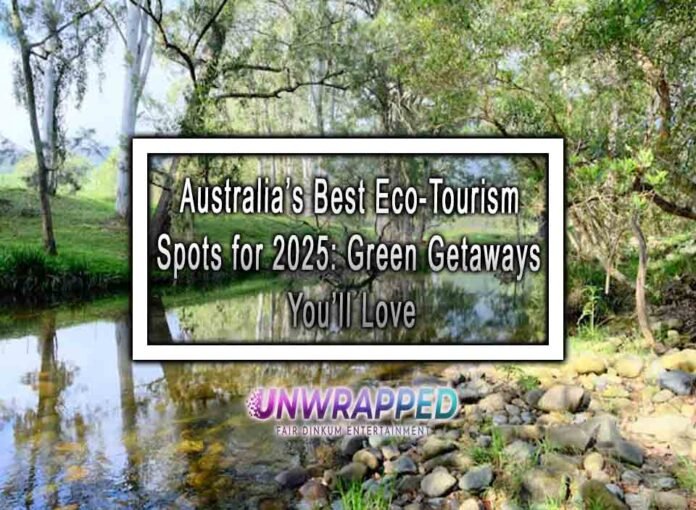Australia’s breathtaking landscapes and unique ecosystems have long been a magnet for travelers. In recent years, the nation’s commitment to sustainability has made it a global leader in eco-tourism. From lush rainforests to pristine marine reserves, the country boasts a myriad of destinations that blend natural beauty with sustainable practices.
In 2025, eco-travel in Australia is more accessible and impactful than ever. With a growing number of destinations prioritizing conservation and green initiatives, travelers can explore responsibly while contributing to the preservation of Australia’s natural wonders. Whether you’re an adventure seeker or a nature enthusiast, these eco-friendly destinations promise unforgettable experiences while protecting the planet.
Why Choose Eco-Travel in Australia?
Eco-travel focuses on minimizing environmental impact, supporting local communities, and preserving natural habitats. Australia’s vast and diverse landscapes make it an ideal destination for sustainable tourism. By choosing eco-travel, visitors can:
- Reduce Carbon Footprint: Many eco-tourism providers offer carbon-neutral experiences.
- Support Conservation Efforts: Entry fees and donations often go toward wildlife protection and habitat restoration.
- Experience Unique Wildlife: Australia’s endemic species, such as kangaroos, koalas, and cassowaries, thrive in preserved environments.
Top Eco-Friendly Destinations in Australia for 2025
1. Daintree Rainforest, Queensland
The Daintree Rainforest, part of the Wet Tropics of Queensland, is one of the oldest rainforests on Earth. Visitors can explore this UNESCO World Heritage Site through guided eco-tours that highlight its rich biodiversity. Many accommodations in the area, such as eco-lodges, operate on renewable energy and employ sustainable practices.
2. Great Barrier Reef, Queensland
As the world’s largest coral reef system, the Great Barrier Reef is a must-visit for eco-travelers. Sustainable tourism operators offer eco-certified snorkeling and diving tours. These initiatives focus on reef preservation, including coral restoration projects and educational programs about marine conservation.
3. Kangaroo Island, South Australia
Kangaroo Island is a sanctuary for wildlife and a leader in sustainable tourism. The island’s eco-friendly accommodations and locally sourced cuisine make it a standout destination. Visitors can participate in guided tours to learn about conservation efforts for species like the endangered glossy black-cockatoo.
4. Rottnest Island, Western Australia
Home to the iconic quokka, Rottnest Island is a car-free destination that prioritizes sustainable tourism. Travelers can explore its scenic beaches and cycling trails while staying in eco-certified accommodations. The island’s renewable energy projects and waste reduction initiatives further enhance its eco-credentials.
5. Tasmanian Wilderness World Heritage Area, Tasmania
This vast wilderness area encompasses ancient forests, pristine rivers, and rugged mountains. Eco-travelers can enjoy activities like hiking, kayaking, and wildlife spotting. Local operators focus on preserving the area’s natural beauty, offering low-impact tours and eco-friendly lodging options.
6. Lord Howe Island, New South Wales
A UNESCO World Heritage Site, Lord Howe Island limits visitor numbers to preserve its unique ecosystem. This subtropical paradise is perfect for eco-travelers seeking tranquility. The island’s initiatives include renewable energy use, organic farming, and strict waste management practices.
7. Ningaloo Reef, Western Australia
Ningaloo Reef is a less-crowded alternative to the Great Barrier Reef, known for its whale sharks and vibrant coral reefs. Eco-tourism operators here promote sustainable snorkeling and diving experiences, ensuring minimal disturbance to marine life.
8. Blue Mountains, New South Wales
The Blue Mountains offer stunning landscapes and rich Aboriginal heritage. Eco-friendly accommodations and guided cultural tours emphasize sustainable practices and respect for traditional landowners. Bushwalking and wildlife tours provide an opportunity to connect with nature responsibly.
9. Uluru-Kata Tjuta National Park, Northern Territory
This iconic site holds immense cultural and spiritual significance for the Anangu people. Visitors are encouraged to respect sacred sites and learn about Aboriginal traditions. Sustainable tourism initiatives include eco-certified accommodations and educational programs about Indigenous heritage.
10. Wilson’s Promontory National Park, Victoria
Known as “The Prom,” this national park features diverse landscapes, from sandy beaches to lush rainforests. Eco-tourism initiatives focus on habitat conservation and wildlife protection. Visitors can explore the area through low-impact activities like hiking and birdwatching.
Sustainable Practices to Look For in Eco-Travel
To ensure your travels are eco-friendly, consider these sustainable practices:
- Eco-Certified Accommodations: Look for lodges and hotels with certifications like Ecotourism Australia’s Green Travel Leader program.
- Low-Impact Activities: Choose activities that have minimal environmental impact, such as walking tours or kayaking.
- Support Local Communities: Spend on local businesses, guides, and crafts to boost regional economies.
- Carbon Offsetting: Opt for travel operators that invest in carbon offset programs to neutralize emissions.
How to Plan an Eco-Friendly Trip
- Research Destinations: Choose locations with a strong commitment to sustainability.
- Pack Light and Smart: Bring reusable items like water bottles, shopping bags, and cutlery.
- Travel Responsibly: Use public transport, cycle, or walk whenever possible.
- Respect Nature: Avoid disturbing wildlife and leave no trace behind.
The Impact of Eco-Travel on Conservation
Eco-travel plays a vital role in protecting Australia’s natural heritage. Revenue generated from sustainable tourism supports:
- Wildlife Protection: Funding for research and conservation of endangered species.
- Habitat Restoration: Initiatives to rehabilitate damaged ecosystems.
- Community Development: Empowering local communities through sustainable employment opportunities.
Conclusion: Exploring Australia Sustainably
Eco-travel in Australia for 2025 offers a unique opportunity to explore the country’s unparalleled natural beauty while contributing to its preservation. From the coral reefs of Queensland to the ancient forests of Tasmania, these destinations embody the principles of sustainability and conservation.
By prioritizing eco-friendly practices and supporting local communities, travelers can make a positive impact on Australia’s environment and economy. As the world embraces greener travel habits, Australia remains a shining example of how tourism and sustainability can go hand in hand. Whether you’re snorkeling in the Great Barrier Reef or hiking in the Blue Mountains, every eco-conscious choice helps protect these incredible places for generations to come.










